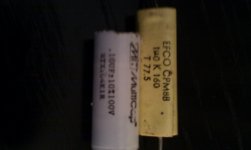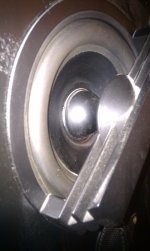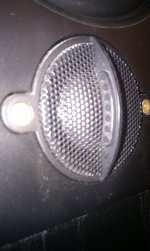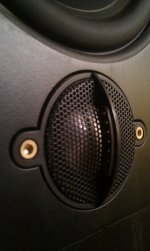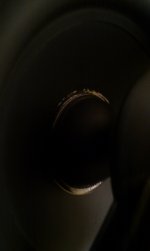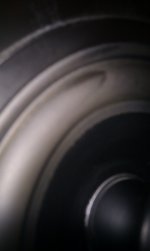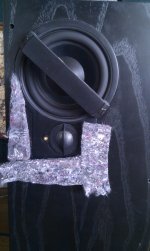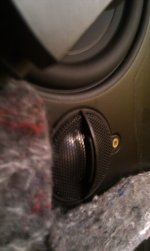Have you opened the tweeter? Dampened with felt under the dome? Often times this area is neglected and is a source of this issue, as are suspension issues, where PVA can be applied sparingly.
Hi greebster,
No, but it's an excellent idea ! Problem the tweeter is tied by behind on an aluminium plate... no screw in front of speaker (just two little but it's for the tweeter acoustic grill... yes the grill is here like the stick for the medium to avoid resonance but....).
I read somewhere that he is ferofluid damped not for temperature but for peak resonance ! 🙄.
I just listen Red Ant a song of the cool Olu Dara a blues man of NY City : the same here that the female voice problem is in the high pitched note of their voices : it's like it urts the ears with ice peak when there is attack of vocal ...don't know if it's harmonics but i surmise yes and i work on the theory given by gentle fellow here : around 5k to 6k Hz !
I'm sad because elsewhere this speaker is nice : amasing soundstage, very tansparent and rapid bass, awsome medium (125 Hz to 2600)
Beginning asking myself if tghe problem could be the medium... but when i bought them 16 years ago I had a measurement : flat between 100 to 15000 ! but was it the good one ?
Odd hobby that we have... but I like that ! When I switch on Kef 104/2 : less transparence but same soundstage without listening fatigue ?! Near the same configuration : the kef is 150 to 2800 with two 4" plastic dome working one a semi apollitto (one of the two doesn't klim higher than the other and is a renforcement for low frequency), the Boston is 125 to 2600 with a single aluminium 5.5" and 1" aluminium tweeter 2600 to 35000 (maybe for dogs who love music !) ; the low mid bass of the kek is amazing but the Boston acoustic goes lower and more transparent : you can hear that with bass string (Rostropovitch) or bass guitar (Marcus miller).
No, but it's an excellent idea ! Problem the tweeter is tied by behind on an aluminium plate... no screw in front of speaker (just two little but it's for the tweeter acoustic grill... yes the grill is here like the stick for the medium to avoid resonance but....).
I read somewhere that he is ferofluid damped not for temperature but for peak resonance ! 🙄.
I just listen Red Ant a song of the cool Olu Dara a blues man of NY City : the same here that the female voice problem is in the high pitched note of their voices : it's like it urts the ears with ice peak when there is attack of vocal ...don't know if it's harmonics but i surmise yes and i work on the theory given by gentle fellow here : around 5k to 6k Hz !
I'm sad because elsewhere this speaker is nice : amasing soundstage, very tansparent and rapid bass, awsome medium (125 Hz to 2600)
Beginning asking myself if tghe problem could be the medium... but when i bought them 16 years ago I had a measurement : flat between 100 to 15000 ! but was it the good one ?
Odd hobby that we have... but I like that ! When I switch on Kef 104/2 : less transparence but same soundstage without listening fatigue ?! Near the same configuration : the kef is 150 to 2800 with two 4" plastic dome working one a semi apollitto (one of the two doesn't klim higher than the other and is a renforcement for low frequency), the Boston is 125 to 2600 with a single aluminium 5.5" and 1" aluminium tweeter 2600 to 35000 (maybe for dogs who love music !) ; the low mid bass of the kek is amazing but the Boston acoustic goes lower and more transparent : you can hear that with bass string (Rostropovitch) or bass guitar (Marcus miller).
Last edited:
Unless it was majorly destructive I would pop them open and inspect.
FF is one way to dampen, but being that old may be part of the problem. As the oil ages it normally thicken changing the viscosity. Perhaps clean and replace while "under the hood".
FF is one way to dampen, but being that old may be part of the problem. As the oil ages it normally thicken changing the viscosity. Perhaps clean and replace while "under the hood".
It's a little too "Experts Boston" for me to inject new FF! But Yes it's an old speaker (89 build) and reviews already talks about this too heary tweeter (test of the 500L in Stereophile)
If you look at the picture before you see that the mid and the tweeter is on a one piece of aluminium glued or screwed by behind; No way to move it. behind there is a trap for the crossover but you can't see the medium-tweeter unit. I read a Lynfield lover thread and the man says that the suround of the tweeter has to be reburn after a non use period of 2 months ?!!!!! He founded that the Lynfireld build under licence in GB have an inverted crossover in the bass. It's a french, I send him an email but don't know if it's a tweaker like us.... I'm afraid not but I think he knows very well the Boston acoustics Lynfield serie.
I think the advice given here are sadly true : if I can't sucess with mechanichal filter which is try & fail method, i haver to sell them or go to a trap notch after measurement ! But I don't believe in my "amateurisme" to do that.
I continue mechanichal method step by step...funny !
If you look at the picture before you see that the mid and the tweeter is on a one piece of aluminium glued or screwed by behind; No way to move it. behind there is a trap for the crossover but you can't see the medium-tweeter unit. I read a Lynfield lover thread and the man says that the suround of the tweeter has to be reburn after a non use period of 2 months ?!!!!! He founded that the Lynfireld build under licence in GB have an inverted crossover in the bass. It's a french, I send him an email but don't know if it's a tweaker like us.... I'm afraid not but I think he knows very well the Boston acoustics Lynfield serie.
I think the advice given here are sadly true : if I can't sucess with mechanichal filter which is try & fail method, i haver to sell them or go to a trap notch after measurement ! But I don't believe in my "amateurisme" to do that.
I continue mechanichal method step by step...funny !
Last edited:
I don't know if you all realize it but the pictures shown are of the Lynfield tweeter from Boston Acoustics that is unique in having a built in notch filter. The bridge over the tweeter has some sideways holes that create a notch filter at one of the high dome break up mode frequencies. I think they got a patent on it. (A Phil Jones invention, if I remember correctly.)
I suspect that if you aren't happy with the frequency balance you want something that is a little more broad in effect. Whats wrong with trying 1 or 2 Ohms in series with the tweeter? (Or even tone controls)
David
I suspect that if you aren't happy with the frequency balance you want something that is a little more broad in effect. Whats wrong with trying 1 or 2 Ohms in series with the tweeter? (Or even tone controls)
David
Hi Speaker Dave,
Exact. Phil Jones called it : AMD filter, it's patended and so what... But be sure it's too shiny to have live with her for 16 years and heard some speakers in my life.
Exact. Hunappy with the balance, but perhaps a bump (i try many sources like LP...). there is already a 10 homs // wit a 1 Uf Polycarbonat metalized foil for the roll off at the beginning of the tweeter crossover. It 's on my whish list to try a simple more resistor in serie like you advise (thank for that) but I'm scared that the crossover move down and not sure to do better than Phill Jones... that's why I asked for mechanichal filter... to avoid trap notch I can't do !
I have a cx2 Yamaha preamp with tone if i want... you know how it works if you have a peak or a too high brighness somewhere you reduce globall energy but the brightness stay...
I try too : tweeters outsides (because asymetrical speakers) : it works (read in Stereophile for the 500L) you loose in soundstage... NOT MANY and yes high frequency are taped but not enough.
Exact. Phil Jones called it : AMD filter, it's patended and so what... But be sure it's too shiny to have live with her for 16 years and heard some speakers in my life.
Exact. Hunappy with the balance, but perhaps a bump (i try many sources like LP...). there is already a 10 homs // wit a 1 Uf Polycarbonat metalized foil for the roll off at the beginning of the tweeter crossover. It 's on my whish list to try a simple more resistor in serie like you advise (thank for that) but I'm scared that the crossover move down and not sure to do better than Phill Jones... that's why I asked for mechanichal filter... to avoid trap notch I can't do !
I have a cx2 Yamaha preamp with tone if i want... you know how it works if you have a peak or a too high brighness somewhere you reduce globall energy but the brightness stay...
I try too : tweeters outsides (because asymetrical speakers) : it works (read in Stereophile for the 500L) you loose in soundstage... NOT MANY and yes high frequency are taped but not enough.
Last edited:
You can see the AMDs' filter
The mid is all aluminium...
Look at the double rubber: the one outside is fix but as damping...
Very solid design : 20 years and the rubber are like new one !
The yellow cap is the // with the 10 homs cement resistor at the beginning of the tweeter filter (The MIT i after in the two stages of the fourth order crossover). The cap is an Eurofarad (french industrial and spatial manufacturer of caps) polycarbonat with T option (metalized foil) very stable at change frequency.
yes I think Phil Jones know whta he done here but reviewers too : there was a second version of the flag ship boston 500 which use same units... maybe i read that the rubber of the mid was harder in the 500L than the one used in the 400L (myth?)
The mid is all aluminium...
Look at the double rubber: the one outside is fix but as damping...
Very solid design : 20 years and the rubber are like new one !
The yellow cap is the // with the 10 homs cement resistor at the beginning of the tweeter filter (The MIT i after in the two stages of the fourth order crossover). The cap is an Eurofarad (french industrial and spatial manufacturer of caps) polycarbonat with T option (metalized foil) very stable at change frequency.
yes I think Phil Jones know whta he done here but reviewers too : there was a second version of the flag ship boston 500 which use same units... maybe i read that the rubber of the mid was harder in the 500L than the one used in the 400L (myth?)
Attachments
Last edited:
That 10 ohm resistor with 1uF cap stands out as a simple place to try tweaking things. Disconnecting the cap would reduce the higher frequencies. On the other hand if your issue is with the middle treble then increasing this cap might bring the upper treble into line if it is lacking, otherwise changing this resistance could be equally helpful in the ways already mentioned.
Thanks AllenB & SpeakerDoctors,
I will try this way.
I understood reading litterature than the 1 uf // with 10 homs do like increasing low frequency when the frequency curve dive. Did I missunderstand ?
hé hé I have to try all these things.
Thanks
I will try this way.
I understood reading litterature than the 1 uf // with 10 homs do like increasing low frequency when the frequency curve dive. Did I missunderstand ?
hé hé I have to try all these things.
Thanks
If you are still looking for Acoustical Damping, here is something I tried as an experiment.
Between the grill and the tweeters I put a thin layer of Poly batting from the fabric store, though places like Walmart also have it. The Poly Batting has just enough 'fuzz' texture that it will cling to the grill, and that will help hold it away from the tweeter.
While being reasonably transparent, it also has reasonable sound absorbing properties, depending on the thickness and density.
This comes in various thicknesses and is sold by the foot. I think it can be as thin as 1/8" and as thick as 3" or 4". Some where in that range much be something that will work for you.
Though I think simply changing the attenuation resistors is probably a better choice.
Just a thought.
Steve/bluewizard
Between the grill and the tweeters I put a thin layer of Poly batting from the fabric store, though places like Walmart also have it. The Poly Batting has just enough 'fuzz' texture that it will cling to the grill, and that will help hold it away from the tweeter.
While being reasonably transparent, it also has reasonable sound absorbing properties, depending on the thickness and density.
This comes in various thicknesses and is sold by the foot. I think it can be as thin as 1/8" and as thick as 3" or 4". Some where in that range much be something that will work for you.
Though I think simply changing the attenuation resistors is probably a better choice.
Just a thought.
Steve/bluewizard
Last edited:
split/thin toilet paper hanging in front of tweeter works 😉
(attenuation may depend on quality, layers, thickness, etc)
since its an alu tweeter, its probably a spike, and needs more 'caretaking'
but try the paper trick ... you might be lucky
I tiried with 3 layers toilett paper and this is with only one layer put behind the synthetic fabric gasket : it's better.
The soudstage is very less larger : in the middle, and the most incredible : the speakers totaly diseaper.
Don't have the time to find openn reticuled sell foam yet.
Somebody tells me that there were two Boston Acoustic 400L , is there anybody here having the shematics of the crossover ? 500L apreciate too.😎
The Boston 500L (same drivers in two boxes that the 400L maid in one box) is said to have a better subjective tonal balance and have 1,5 homs in serie (seen on a picture in the Web) for the mid unit against 2 homs for mine. Is it a good idea to improve the level by reducing resistor in the mid to solve the tweeter balance ?
I plan after to DIY a planar with the good ideas of the Planar section's fellows, but very embarrassing with my Boston Lynfield...some says than they are far better than a Sacha or a an actual Verity audio. they have a very fast bass with their double inversed speeder (two 17cm bass unit, closed symetrical load, fast mid without metalic ringing according the uniq design of the 13cm, incredible soundstage, but known for a non klimbing tweeter that I didn't found for this last in relation with another speaker like old Kef 104/2 ref (with Ferrofluid in the tweeter too if i remenber) !
Is it easy to inject ferrofluid in a tweeter which loose its fluid ? Want to try everything before sell them for a low price and make happy a futur seller !
Thanks again
Hi fellows,
I have experimented some of your answers and I progress (thank you🙂)
So the 2 layer toilett paper paddle a little th treble range and add a little warmess...not bad at all but i have always my brighness.
Swaped the cement resistor with its selfic effect with the non inductive Mundorf M resist... brighter...come back with cement after 5 hours !
the toilett paper stay but add 1 hom yesterday in front of the treble crossover (10 homs//1uF) : surprise more mid bass and bass impacts (better) but the brighness, harchness in the treble is always here...the sound is a little damped (warmer...) but I believe the brighness in the treble increase (maybe because the lower treble make the peak more listenable ?!).
I have been cutting reticuled foam to put arround the tweeter. test tomorrow.
I have to look for feld too.
Will try to increase the caps in the 10 homs//1uF entry treble crossover.
Is there please any internet programm or freeware to calcul a dip notch, L-pad according to the frequency ?
Nobody knows an Boston Lynfield 400 or 500 owner around ? (I surmise the 400L2 is maybe better and the 500L2 too, I ask to a french owner who had alls the series but he seems jealous of his knowledge...no answers about the crossover design ! Could it be possible to have the plan from Boston Acoustics according to you ? )
I continue because it seems the quality of this speaker can be increased !
I have experimented some of your answers and I progress (thank you🙂)
So the 2 layer toilett paper paddle a little th treble range and add a little warmess...not bad at all but i have always my brighness.
Swaped the cement resistor with its selfic effect with the non inductive Mundorf M resist... brighter...come back with cement after 5 hours !
the toilett paper stay but add 1 hom yesterday in front of the treble crossover (10 homs//1uF) : surprise more mid bass and bass impacts (better) but the brighness, harchness in the treble is always here...the sound is a little damped (warmer...) but I believe the brighness in the treble increase (maybe because the lower treble make the peak more listenable ?!).
I have been cutting reticuled foam to put arround the tweeter. test tomorrow.
I have to look for feld too.
Will try to increase the caps in the 10 homs//1uF entry treble crossover.
Is there please any internet programm or freeware to calcul a dip notch, L-pad according to the frequency ?
Nobody knows an Boston Lynfield 400 or 500 owner around ? (I surmise the 400L2 is maybe better and the 500L2 too, I ask to a french owner who had alls the series but he seems jealous of his knowledge...no answers about the crossover design ! Could it be possible to have the plan from Boston Acoustics according to you ? )
I continue because it seems the quality of this speaker can be increased !
Hi guys,
Yesterday evening, needled felt was tried before foam (the foam i have is open...but rigid : used into package for choc protection).
Well, a very small difference... i have to try more resistor. i have no L-pas in the treble crossover, is it because the driver is damped with ferrofluid ?
according to you with my 10 homs//1 Uf ? whichs step of value do I need to hear a difference in treble ? 1 hom, 3 homs ? more ? because just with 1 hom in front of it I had an increase of mid bass impact and bass presence.
In case of adding a L pad is the // resistor the double value of the serie one ? (I don't knwow exactly the impedance of the driver unit, but the entire nominal speaker impedance is 6 homs and the mid dip at 3 homs at 120 hz...
Yesterday evening, needled felt was tried before foam (the foam i have is open...but rigid : used into package for choc protection).
Well, a very small difference... i have to try more resistor. i have no L-pas in the treble crossover, is it because the driver is damped with ferrofluid ?
according to you with my 10 homs//1 Uf ? whichs step of value do I need to hear a difference in treble ? 1 hom, 3 homs ? more ? because just with 1 hom in front of it I had an increase of mid bass impact and bass presence.
In case of adding a L pad is the // resistor the double value of the serie one ? (I don't knwow exactly the impedance of the driver unit, but the entire nominal speaker impedance is 6 homs and the mid dip at 3 homs at 120 hz...
Attachments
You can put a 33-47 ohm resistor in parallel with the driver for a small difference. If it helps, use lower.
If you go too low, you might need to change the other components.
If you go too low, you might need to change the other components.
Thank you AllenB,
I haven't such values, so i have to buy it, that's not too expensive... I give it a try as soon as I receive them.
What do you think of the step value to be used in serie, do i have to increase hom by hom or 3 homs by 3 homs to hear a difference with treble?... Or by 0,5 hom steps maybe?
I haven't such values, so i have to buy it, that's not too expensive... I give it a try as soon as I receive them.
What do you think of the step value to be used in serie, do i have to increase hom by hom or 3 homs by 3 homs to hear a difference with treble?... Or by 0,5 hom steps maybe?
Yes on page 2 (picture)
I remove the 1 uF // with the 10 homs (and remove too the 1 Hom I add in serie) :
medium is thinner but mid bass and bass still here . Voice and Ben Webster sax are thinner...but it seems it's neutral in the treble (not sure yet...i have to listen more (alwas the same songs to be sure of course)...maybe less shiny, so i presume the brighness was under 5000 hz between 2600 (crossover) ?
I really have to write a mail to nice people of Boston Acoustics to have shematic of the two Boston Lynfield 400L & 400 L2 and the flagship 500L Mk2 (sames drivers but in two box...a little more bass). A french guy said to me that Phill Johnes don't design the crossover of the 400L but only the 500l and the little 300L ! But assume that Boston Acoustics were inspired by these two crossovers to maid the 400L !
The mid seems indestructible, but maybe like it was said here : the treble has now a more viscous ferrofluid (dry). The french guy who has all the models says that it's a sweet speakers in the treble with fabulous mid bass and fast bass... I hears all, also the soundstage and the diseapper of the box (better with the toilett paper tip : image more on the center) but not the sweet treble yet...in relation to my beloved Kef 104/2... i 'm going to marry with these last one ! the little felt i added makes nothing (0,4" thick), but maybe too little and impossible to putt between the two drivers : lake of space !)
I remove the 1 uF // with the 10 homs (and remove too the 1 Hom I add in serie) :
medium is thinner but mid bass and bass still here . Voice and Ben Webster sax are thinner...but it seems it's neutral in the treble (not sure yet...i have to listen more (alwas the same songs to be sure of course)...maybe less shiny, so i presume the brighness was under 5000 hz between 2600 (crossover) ?
I really have to write a mail to nice people of Boston Acoustics to have shematic of the two Boston Lynfield 400L & 400 L2 and the flagship 500L Mk2 (sames drivers but in two box...a little more bass). A french guy said to me that Phill Johnes don't design the crossover of the 400L but only the 500l and the little 300L ! But assume that Boston Acoustics were inspired by these two crossovers to maid the 400L !
The mid seems indestructible, but maybe like it was said here : the treble has now a more viscous ferrofluid (dry). The french guy who has all the models says that it's a sweet speakers in the treble with fabulous mid bass and fast bass... I hears all, also the soundstage and the diseapper of the box (better with the toilett paper tip : image more on the center) but not the sweet treble yet...in relation to my beloved Kef 104/2... i 'm going to marry with these last one ! the little felt i added makes nothing (0,4" thick), but maybe too little and impossible to putt between the two drivers : lake of space !)
Last edited:
Yes, less fatigue without the 1uf cap...strange, it seems really flatter and less density. In the same time I have to increase the volume to have the impression of same quantity of decibel.
I have to put again the 1 hom in serie and staying without the cap. wait the resistors by post too.
It's antic technic (without measure and micro...but when I listen to music I don't look at the micro and the measurement !...but I really have to buy a cheap micro to DIY my next speaker...)
I have to put again the 1 hom in serie and staying without the cap. wait the resistors by post too.
It's antic technic (without measure and micro...but when I listen to music I don't look at the micro and the measurement !...but I really have to buy a cheap micro to DIY my next speaker...)
Had a very fast answer of Boston Acoustics : they had no archives of these models and can't provide any shematics... (Did Phill Jones burn all the documents before escaping bythe window ????).
ok for the moment there is no possible come back with the 1 uf//10 homs...less better without the cap !
ok for the moment there is no possible come back with the 1 uf//10 homs...less better without the cap !
@ What Frequencie(s) ? [1]
[1] Audio Tests, Test Tones and Tone Generators - Online and Free.
Regards,
WHG
hi,
is it possible to make an acoustical filter for an 1'' aluminium dome tweeter which is too brillant and cause listning fatigue?
it has a metal grill and I think of something with cotton wool or a remover make-up pad fixed with blue tack or adhesive tape ? Maybe foam ? The higher frequency are near the center of the dome so do i place a cotton wool or cotton shet just upon the grill in the center ? I tied with different sucess...
I think after reading some newsletter about my model that I have some ringing at 5K Hz (a bump between 4 and 6 Khz) or higher and wanted to make an electrical notch on the existing fourth order crossover...but don't know how and have no tools for measurement...
bad ideas ?
[1] Audio Tests, Test Tones and Tone Generators - Online and Free.
Regards,
WHG
- Status
- Not open for further replies.
- Home
- Loudspeakers
- Multi-Way
- acoustical filter for tweeters ?
